Guruvani 2
Added to library: September 1, 2025

Summary
Here's a comprehensive summary of the Jain text "Guruvani Book 2" by Munishri Jambuvijayji, based on the provided pages:
Overall Theme:
This book, "Guruvani Book 2," is a collection of discourses and teachings by Pujyapad Gurudev Muniraj Shri Bhuvanvijayaji Maharaj (Jambuvijayji Maharaj), compiled and edited by Sadhvi Shri Jinendrapra. It focuses on guiding householders (Shravaks) towards a righteous path by elaborating on essential virtues and practices within Jainism. The book emphasizes the practical application of dharma in daily life, aiming to transform individuals into true devotees.
Key Teachings and Concepts:
The book delves into various aspects of Jain conduct and philosophy, presented through elucidations of scriptures and inspirational anecdotes. Here's a breakdown of the major themes and virtues discussed:
-
The "Dharmaratna Prakaran": The core of the teachings in this volume is based on the "Dharmaratna Prakaran," a text by Shri Shantisuriji. The first part of "Guruvani" had already covered four virtues of an ideal Shravak, and this second part discusses the remaining six:
- Akroorta (Not Cruel/Harsh): This section emphasizes the importance of controlling anger, pride, deceit, and greed (kashayas). An anecdote of an old, short-tempered man who transformed his life by controlling his anger illustrates this point. The text stresses that true dharma lies in overcoming inner passions.
- Pāpbhīru (Fearful of Sin): This virtue highlights the need for constant vigilance against committing any sin, even in business. The example of Sulsa, a butcher's son who renounced his family's sinful trade after witnessing his father's suffering, underscores the importance of avoiding activities that cause harm to living beings. It also touches upon the concept of right livelihood and the detrimental impact of unrighteous wealth.
- Sudākṣiṇyata (Benevolence/Kindness): This virtue stresses the importance of compassion, helpfulness, and empathy towards others, especially fellow Jains (Sādharmiks). The book traces the origin of Sādharmik Vātsalya to Emperor Bharat and highlights the immense contributions of figures like Acharya Hemchandrasuri in promoting non-violence and kindness. It also narrates stories of generosity and commitment to Jain principles.
- Lajjā (Modesty/Shame): This virtue is presented as the "mother of virtues," crucial for maintaining moral integrity and preventing wrongdoings. The text contrasts past societal norms emphasizing modesty and respect with the current erosion of these values. The story of Chandrarudracharya and his devoted disciple who achieved Kevalgyana through adherence to modesty serves as a powerful example.
- Dayā (Compassion): The foundational principle of Jainism, compassion, is elaborated upon. The text criticizes the wastage of water and the practice of unnecessary violence in everyday life, contrasting them with the exemplary conduct of Jain monks and the inherent compassion in Jain practices like not harming plants unnecessarily.
- Dyakṣiṇya (Dexterity/Skill in Action): This virtue, while not explicitly detailed in the provided summary of virtues, is linked to the ability to act righteously and effectively. The examples of historical figures often demonstrate their skill in both worldly affairs and spiritual pursuits.
-
The Role of Sādharmiks: The book places significant emphasis on the importance of the Jain community (Sangh) and the interconnectedness of its members. The concept of "Sādharmik Vātsalya" is presented as a powerful force that supports spiritual growth and societal well-being. The stories of wealthy individuals dedicating their fortunes to supporting fellow Jains and maintaining religious institutions highlight this.
-
The Path to Moksha: The ultimate goal of Moksha (liberation) is implicitly or explicitly mentioned as the driving force behind these teachings. By cultivating virtues and adhering to religious practices, individuals can purify their souls and progress on the path to liberation.
-
Historical Figures and Their Lives: The book draws heavily on the lives and teachings of prominent Jain figures throughout history, including:
- Acharya Vijay Meghasurishwarji: Guru of Munishri Bhuvanvijayaji.
- Sadhviji Shri Manoharshriji: Revered as the "Guru Mata" and mother of Munishri Jambuvijayji, her life story of devotion and penance is detailed.
- Acharya Hemchandrasuri: A pivotal figure who influenced King Kumarpal, promoting widespread adherence to Jain principles like non-violence.
- Munishri Hirharsh Suriji: His life and impact on propagating dharma are discussed.
- Vastupal and Tejpal: Renowned ministers and patrons of Jainism, their stories of devotion, philanthropy, and building magnificent temples are narrated.
- Jagadusha: Another prominent figure celebrated for his Sādharmik Vātsalya.
- Karmaha: Whose immense devotion led to significant temple renovations and installations.
- Indrabhuti Gautam: The first Ganadhara of Bhagwan Mahavir, his intellectual journey and eventual surrender to the teachings are explained, addressing philosophical debates about the soul.
- Chandanbala and Mrigavati: Exemplary female disciples whose lives demonstrate the power of righteousness and forgiveness.
-
Rituals and Practices: The book also touches upon important Jain observances like Paryushan, the significance of fasting (tapasya), and the reverence for temples (Chaitya Paripati).
-
The Nature of the Soul (Atma): A significant portion of the text engages with philosophical questions about the existence and nature of the soul, drawing from Vedic texts and the teachings of Bhagwan Mahavir to establish the soul as distinct from the physical body and its constituent elements.
Structure and Tone:
The book is presented in a devotional and instructional tone. Each chapter or section likely focuses on a specific virtue or story, making the complex principles of Jainism accessible to the common reader. The use of anecdotes and examples from the lives of saints and historical figures makes the teachings relatable and inspiring.
Purpose:
The ultimate aim of "Guruvani Book 2" is to encourage readers to cultivate these virtues, deepen their understanding and practice of Jain dharma, and ultimately strive for spiritual liberation. It serves as a practical guide for householders to live a life aligned with Jain principles.